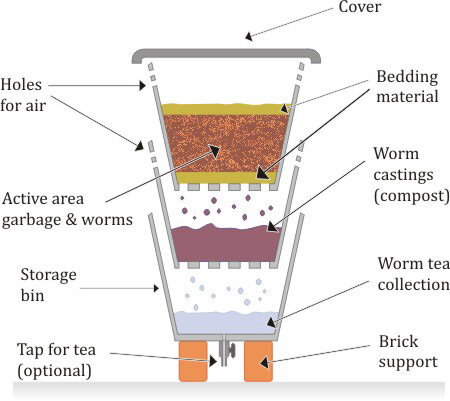Red Wiggler Composting Worms, photo from http://working-worms.com/how-to-make-your-own-worm-farm/
People often ask us the best way to compost food scraps in a home environment. While tumbler systems and three bay pallet systems have some benefits, we almost always recommend families start with a worm system!
Worm composting, or vermicomposting, is the fastest form of composting one can attempt at home requiring around 6 months to convert food scraps into ready-to-use black gold compost. Vermicompost is different from other forms of composting because, rather than using bacteria and the heat they produce to break down food scraps, it primarily relies on worms’ digestive system! While the compost that comes out of a tumbler is often chunky and only partially decomposed, a worm bin yields crumbly, friable, ready-to-use fertilizer that doesn't smell bad.
But not all worms are equal! Red Wiggler worms, not earthworms, are used for composting. In ideal conditions, they can eat up to ½ of their body weight in a day! Other characteristics of these worms (the fact that they don’t dig very deep, their aversion to light) are also put to use in most vermicomposting systems.
No matter the system, what goes in it will be the same. Worms require food scraps, of course. Like most compost systems, you’ll want to avoid dairy, meat, or anything that’s been cooked with oil or fat. But worms also don’t like anything that is particularly pungent like hot peppers, citrus, and onions. They love coffee grounds, apple cores, banana peels and they will actually mate in eggshells.
In addition to food scraps, you’ll need to add “bedding.” Bedding can be anything from leaves, to coconut coir, to shredded paper and cardboard. Bedding adds carbon to the compost, but it also provides the worms with an ideal environment. There should be a 1-2 inch layer of bedding on top of any food scraps to give the worms cover from light and to trap in the right amount of moisture. Bedding should be damp but not wet - if you pick up a handful it shouldn’t drip, but you should be able to squeeze out a few drops of moisture.
Types of Vermicomposting Systems:
A worm bin made from Tupperware containers, photo from https://www.canr.msu.edu/news/worm_composting_or_vermicomposting
The simplest and cheapest system can be made out of two large tupperware bins. Drill small holes in the bottom and larger hole in the sides and top of one container. Place bricks in each corner of the other - this will be the base. Place the bin with holes inside of the base bin and on top of the bricks so that it’s “floating” by a few inches. Add worms and bedding in the bin with holes. The holes in the bottom allow for excess moisture to drain into the base bin while the holes in the tops and sides allow for airflow. An upgraded system will also include a spigot in the bottom bin to drain out the ‘worm tea’ and a third bin on top to allow for upward migration.
Pros:
Relatively inexpensive and easy to diy
The large bins can create a decent amount of compost
Cons:
Bulky
Involved and messier harvest process
Upward Migration System, photo from http://working-worms.com/how-to-make-your-own-worm-farm/
The most common vermicomposting system for households is an upward migration system, also called a “worm hotel.” These systems are composed of at least three trays with mesh bottoms. They stack on top of one another allowing for the worms to crawl freely between them. Start with one tray and as it fills up you add another tray and another until they are all full. The worms will crawl up towards the surface and towards new food as they finish the food in the bottom tray. By the time all of the trays are filled, the bottom tray should be ready to harvest.
Pros:
clean, compact, and presentable
easy harvest
Cons:
More of an Investment
Smaller bins mean smaller harvests
Find more info about how to start vermicomposting here!




